
Ang Mo Kio is a planning area and residential town situated in the North-East region of Singapore. Located approximately 11 km (6.8 mi) north of the Downtown Core district, Ang Mo Kio is the 3rd most populated planning area in the North-East region and ranks 8th in terms of population in the country overall. The planning area is located at the south-western corner of the North-East region, bordered by the planning areas of Yishun to the north, Sengkang to the north-east, Serangoon to the east, Bishan to the south and the Central Water Catchment to the west.

Changi Prison Complex, often known simply as Changi Prison, is a prison complex in the namesake district of Changi in the eastern part of Singapore. It is the oldest and largest prison in the country, covering an area of about 50 ha. Opened in 1936, the prison has a rich history.

The Housing & Development Board, is a statutory board under the Ministry of National Development responsible for the public housing in Singapore. Established in 1960 as a result of efforts in the late 1950s to set up an authority to take over the Singapore Improvement Trust's (SIT) public housing responsibilities, the HDB focused on the construction of emergency housing and the resettlement of kampong residents into public housing in the first few years of its existence.

Sook Ching was a mass killing that occurred from 18 February to 4 March 1942 in Singapore after it fell to the Japanese. It was a systematic purge and massacre of 'anti-Japanese' elements in Singapore, with the Singaporean Chinese particularly targeted by the Japanese military during the occupation. However, Japanese soldiers engaged in indiscriminate killing, and did not try to identify who was 'anti-Japanese.' Singapore was a crucial strategic point in World War II. From 8 February to 15 February, the Japanese fought for control of the city. The combined British and Commonwealth forces surrendered in a stunning defeat to the outnumbered Japanese on 15 February which led to its fall. The loss of Singapore was and still is Britain's largest surrender in history.
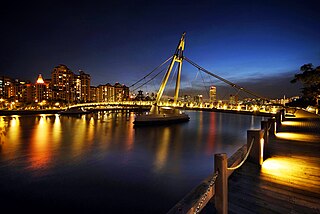
Kallang is a planning area and residential zone located in the Central Region of Singapore.
Tiong Bahru is a housing estate located within the Bukit Merah Planning Area, in the Central Region of Singapore. Tiong Bahru was constructed in the 1920s by the Singapore Improvement Trust, the predecessor to the Housing Development Board (HDB) and an entity of the British colonial authority providing mass public housing in Singapore and is the oldest housing estate in Singapore. The main estate consists of 30 apartment blocks with over 900 units of two to five rooms that are also commonly referred to as "walk-ups". There are also high-rise HDB flats and condominiums along Boon Tiong Road, Jalan Membina and Kim Tian Road which surround the main estate.
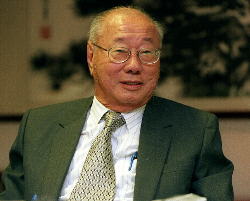
Lim Kim San was a Singaporean businessman, civil servant, and politician who served as a Cabinet minister with a variety of portfolios between 1965 and 1981. Prior to his tenure as a member of parliament, Lim was appointed chairman of Singapore's newly created Housing & Development Board (HDB), and he would go on to be recognized for the HDB's success in its resolution of Singapore's housing shortage.
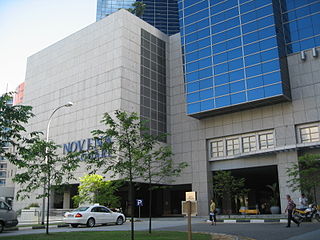
Novena is a planning area located within the Central Region of Singapore. Novena is bounded by Toa Payoh to the north, Bukit Timah to the west, Tanglin to the south and Kallang to the east. While Novena is not classified as a "new town" by the Housing and Development Board (HDB), the estate of Whampoa within the subzone of Balestier constitutes part of the Kallang/Whampoa New Town.
View Road Hospital was located at View Road, off Admiralty Road West, in Woodlands, Singapore. It was used to as a branch of Woodbridge Hospital used for occupational therapy for long term schizophrenia patients and was closed in 2001. The has been used on two occasions as a foreign workers dormitory known as View Road Lodge on two occasions from 2008 to 2017. It is now unoccupied.

The Singapore Improvement Trust (SIT) is a former government organisation that was responsible for urban planning and urban renewal in Singapore. Formally established in 1927 under the Singapore Improvement Ordinance, it was modelled after similar organisations in India. The SIT initially carried out back lane improvement schemes and marking out unsanitary buildings for demolition, but began constructing public housing from 1935. After 1945, the SIT initially focused its efforts on the repair of its residential developments. It resumed constructing public housing in 1947 but was unable to keep up with demand. The SIT was also involved in the development of a "Master Plan", which set out Singapore's developmental direction, from 1952 to 1958. In the late 1950s, plans were set out to replace the SIT with two departments—housing and planning—culminating in two bills that were passed in 1959. With the establishment of the successor organisations by the government of Singapore, the Housing and Development Authority and the Planning Authority, in 1960, the SIT was dissolved.

The Woodlands Checkpoint is one of Singapore's two land border checkpoints, connecting ground traffic with Malaysia. It services the vehicular traffic along with pedestrians that goes through the Johor–Singapore Causeway. The only other Singapore land border checkpoint services the Malaysia–Singapore Second Link.
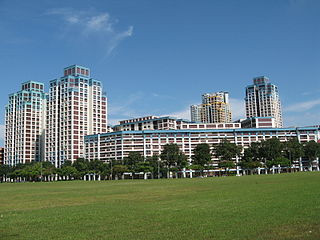
Public housing in Singapore is subsidised, built, and managed by the Government of Singapore. Starting in the 1930s, the country's first public housing was built by the Singapore Improvement Trust (SIT) in a similar fashion to contemporaneous British public housing projects, and housing for the resettlement of squatters was built from the late 1950s. In the 1960s under the SIT's successor, the Housing and Development Board (HDB), public housing consisting of small units with basic amenities was constructed as quickly and cheaply as possible at high densities and used for resettlement schemes. From the late 1960s, housing programmes focused more on quality, public housing was built in new towns, and a scheme allowing residents to lease their flats was introduced. Throughout the 1970s and 1980s, more public housing options were provided for the middle class and efforts to increase community cohesion within housing estates were made. From the 1990s, the government began portraying public housing as an asset, introducing large-scale upgrading schemes and loosening regulations on the resale of public housing while additional housing programmes for the sandwich classes and elderly residents were introduced. Rising housing prices led to public housing being seen as an investment from the 2000s, and new technologies and eco-friendly features were incorporated into housing estates.

Hillview is located in Upper Bukit Timah, Northwest Singapore. The neighbourhood overlooks Bukit Timah Hill, hence its name.

Fairfield Methodist School (Primary) and Fairfield Methodist School (Secondary) are two schools located on Dover Road. Founded in 1888 as the Telok Ayer Girls School, they are among the oldest primary and secondary schools in Singapore. Their current premises are at the neighbourhood of Dover in Queenstown, Central Singapore.

Sir Han Hoe Lim was a Singaporean physician and politician.
David Joseph Murnane (1892–1953) was Singapore's longest serving municipal water engineer, serving from 1925 to 1947.
James MacRitchie was Municipal Engineer to the Singapore Municipal Commission from 1883 to 1895. Singapore's oldest reservoir MacRitchie Reservoir was named after him in 1922.

Alkaff Gardens was a Japanese-style park once located east of the Bidadari Cemetery from 1930 to 1964, on the present site of Cedar Girls' Secondary School at Bidadari, Singapore. In the 1930s, the park was a popular leisure destination for dating couples and families. It featured as its centrepiece an artificial lake, which was drained in 1964.
The Keppel Hill Reservoir is an abandoned reservoir near Mount Faber in the southern part of Singapore. It was built during the colonial period of Singapore. It fell into disuse due to its small capacity and was eventually forgotten.
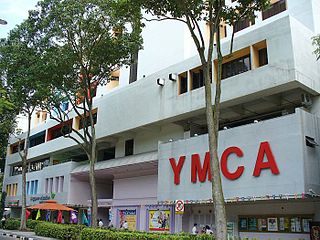
The YMCA Building is the current headquarters of YMCA of Singapore. It also operates a hotel under the name of YMCA @ One Orchard.
















